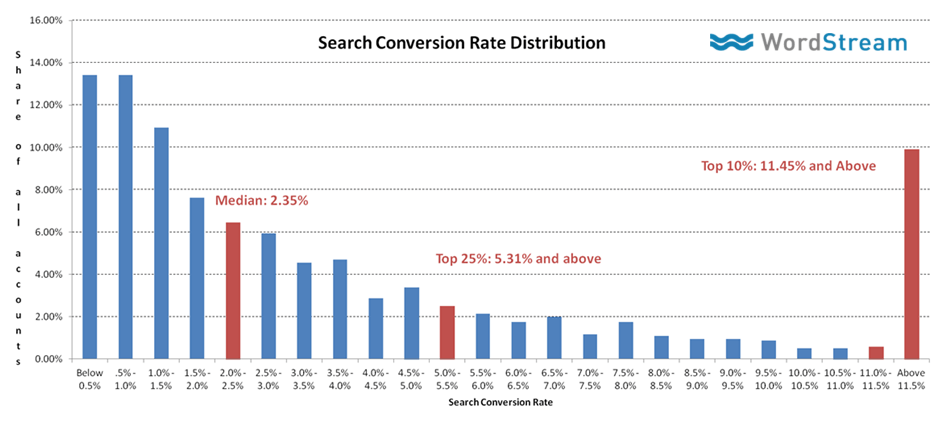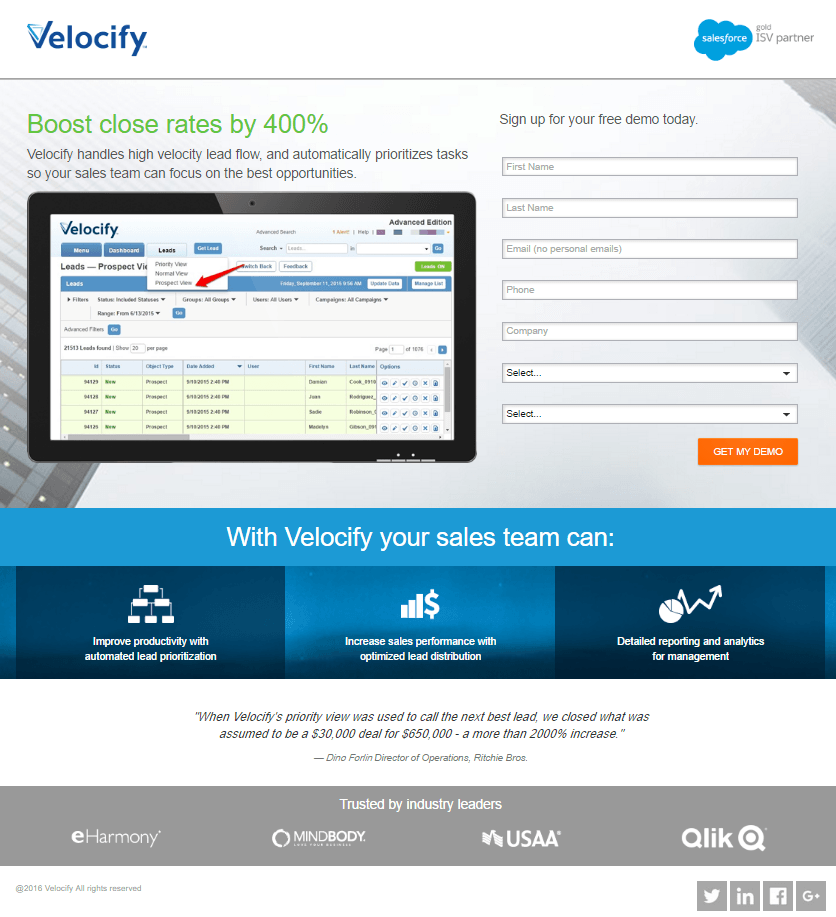The answer to your question “What’s a good conversion rate?” is simpler than you think. Unfortunately, you’re not going to like it. Ready?
A higher one. A good conversion rate is one that’s higher than it is now. So why are you searching for an actual number?
If you want to compare yourself to everybody else, there are industry benchmarks, sure. But, the problem with those statistics is that there’s a whole lot they don’t take into account.
To boost your conversion rate from where it is to where it should be, first you have to understand this…
Your business is unique
In the sport of distance running, it’s not uncommon to hear the advice “Run your own race” from coaches of all levels. Here’s why…
Let’s say you’re on the start line of a 10k, knowing you’re capable of running 8-minute mile pace over the 6.2-mile course. Naturally, your goal will be to run right around 8 minutes, or just under, for each mile of the race.
But, when the gun sounds and the race starts, you get caught up in the excitement and take off with the leaders, who happen to be moving at a pace much faster than your goal.
Together you cover the first mile in 6 minutes, the second in 7, and by the third, you’ve already spent so much of your energy that you have to drop out of the race. The leaders, on the other hand, continue to the finish seemingly effortlessly.
Now, if you’re a beginner, it’s tempting to run with the leaders. To the naked eye, these people are just like you. They’re in shorts, running shoes, and a tank top. They stride similarly and pump their arms the same way. So why are they able to run a faster overall time?
For lots of reasons — none of which you can discover by looking at them on the start line.
Veterans understand this. There are so many variables at play — your competitors’ training, their lung capacity, their pain tolerance, etc. — that can’t be gathered strictly from appearance.
If you run your own race — meaning, do what you’re capable of and don’t concern yourself with your opponents — you’ll perform better overall.
In digital marketing, there are just as many variables contributing to a business’s conversion rate — which is why you can’t compare yourself to them either, even if based on appearances, they’re similar to you.
It doesn’t matter if they’re in the same industry, selling a comparable product, or using a familiar brand voice. In a short rant on CXL, Peep Laja explains why:
Even if you compare conversion rates of sites in the same industry, it’s still not apples to apples. Different sites have different traffic sources (and the quality of traffic makes all the difference), traffic volumes, different brand perception and different relationship with their audiences.
Most ecommerce sites compete with Amazon one way or another. So will knowing Amazon conversion stats help you in any way?
Amazon Prime members convert at 74%. That’s a sign of a strong client relationship. Non-Prime members convert at 13%.
Now what will you do differently? Let me tell you: nothing at all.
So when you see statements like, “The average ecommerce post-click landing page converts at 5%,” you can use them as an inaccurate measuring stick, or you can dive into your own data to see where you’re falling short, then try to boost your post-click landing page’s conversion rate with the most popular and effective method of optimization.
What is A/B split testing?
A/B testing, also known as split testing, is a method of optimization that involves testing two different versions of a post-click landing page against each other — the control (A), and the variation (B) — to see which performs better.
The tester starts by diving into analytics to see where the original page is falling short, then proposes optimizations to fix those issues on the variation page.
For example, let’s say a heat mapping tool shows your call-to-action button isn’t getting noticed, so, you decide to test something more attention-grabbing.
After driving equal traffic to both, and reaching statistical significance, you find the variation is converting at 2% higher. And the reason why has to do with the change in CTA button color, since that’s the only difference between the two pages.
Sometimes, though, this method of testing isn’t ideal. Many businesses don’t have access to the massive amount of traffic required to complete A/B tests promptly.
And even if they do, there’s still one big problem with this “change one element per test” method.
A/B testing for big lifts
In a study of post-click landing page conversion rates across industries, WordStream CEO Larry Kim found that the best marketers were converting more than 11.5% of their visitors:

Now, we’re not sharing this graphic with you so you start comparing yourself to them. We’re sharing it to show you what’s possible. If you were satisfied with 2 or 3%, this should change your mindset.
So how do you become a member of that top 10%? Not by testing elements that will have only a minor impact on conversion, says Kim:
“The small-fry, basic optimizations mentioned above (line spacing, button placement, font colors, etc.) are simply table stakes for post-click landing page design. They may result in small, single-digit increases in conversion, but won’t get you to the top of the pile.”
If you want big changes, you have to make big changes — meaning that if you expect to see a conversion lift higher than 1 or 2%, you should test your page’s most important elements.
Do you think your time is better spent altering the shading of your logo to see how it affects your conversion rate, or making a more compelling case for downloading your ebook with a clearer overall message?
Even if a small adjustment does bring a lift, chances are it’ll only be a small lift, if at all. Remember, even half of all A/A tests will reach statistical significance at some point.
So, if you want drastically different results, you have to test radically different pages. But, wait a minute…
Is that still technically A/B testing?
Some people will tell you that if you make more than one change from your original to your variation, you’re no longer A/B testing. We disagree. In this case, you’re still testing a control page (A) vs. a variation page (B).
So when you test a variation with a different headline, button color, and call-to-action than your original — all at the same time — you won’t know why your winner is performing better at the test’s conclusion (unless you use multivariate testing), but you will know which page is the better converter. And that’s the knowledge you were after in the first place, wasn’t it?
If you want to run a by-the-book A/B test, be our guest. You’ll know more about why your conversion lifts are happening. But, if you want to boost conversions faster, lump a few changes into one test. And not small ones like button color and line spacing, but impactful ones, like these:
1. A more valuable offer
It doesn’t matter if you’re the most skilled marketer in the world. If what you’re offering isn’t worth what you’re asking, you won’t convert anyone.
Instead of adding another tip sheet or ebook to the millions that are already available on the internet, aim to create something your visitors can actually use.
Test your ebook against a template or a tool like WordStream’s AdWords Grader report card. Test your tip sheet against a step-by-step case study with actionable takeaways.
The more valuable your offer is, the more likely people are to claim it.
2. Skimmable, benefit-centric text
To convince a visitor to convert on your offer, you need to present it clearly with a focus on its benefits. Look at your page and ask yourself:
Is my page skimmable?
Is my font choice legible? Are blocks of text broken down into easily digestible chunks? Have I used bullet points to convey my offer’s benefits quickly? Have I bolded words and used title text to create a visual hierarchy?
Does my headline give readers a reason to stick around?
If you can’t quickly use elements like curiosity, scarcity, and self-interest to convince your visitors to read the first few lines of your copy, they’re going to leave before they even know why your offer is so great.
Have I used the fewest words possible?
People don’t like to read, which is why it’s important to make one word do the work of two on your post-click landing page. Remove any excess fluff or flowery language that doesn’t have a clear purpose.
“Get the super-duper awesome innovative SEO tool used by the world’s best marketers”?
We think you mean, “Get the SEO tool used by the world’s top marketers.”
3. Clearer message match
If your visitors aren’t spending a lot of time on your post-click landing page, it’s likely because you haven’t created good message match between your ad and its destination. Here’s an example of what you don’t want to do…
When searching “Instagram marketing tool,” you’ll likely come across the ad we just did, pictured below:

“Okay,” you think, “let’s see what kind of Instagram marketing tools Velocify has to offer.” If you click the ad, like we did, you’ll end up on this page:

Notice anything, or rather, the lack of something in particular?
There’s no mention of Instagram anywhere on this page. From what we can tell, Velocify is a great lead management tool, but that’s not what we’re looking for.
We wanted an Instagram marketing tool. And because we didn’t get it, we’re going to hit the back button and click search results until we find what we want — just like your visitors will.
Strong message match builds trust. It says, “this is what we told you we had, and here it is.” Bad message match, on the other hand, kills trust with what feels like false advertising.
Don’t become a victim of bad message match. Look at what you’re advertising in that email or PPC search result. Are you delivering on your promise with your offer?
If Velocify does have an Instagram marketing tool, they need to let visitors know on the page. If they don’t, they shouldn’t be bidding on the keyword phrase “Instagram marketing tool.”
Until they make those changes, they’re losing money.
4. A stronger case for claiming your offer
In your opinion, your offer is the best around. Unfortunately, on your post-click landing page, your own opinion doesn’t matter.
Just like you wouldn’t believe the “World’s best fish tacos” sign hanging in the window of your local taco shop, your visitors won’t believe that your offer is the best around if you’re the one to tell them.
Instead, use social proof like company badges and testimonials to showcase the big names who have found your offer valuable.
Use specific statistics like “How Autopilot Used Instapage to Grow Conversions by 254%,” to show that your tool works instead of saying it.
As many as 88% of buyers trust online reviews as much as a personal recommendations. If your page is lacking them, it’s time to test a new variation.
5. The right media
Are visitors going to need to see a video from your founder to decide whether or not they should hand over their name and email in exchange for your ebook?
Probably not. That’s usually overkill for a low-commitment offer. But, a one-page preview image of the ebook would work persuasive wonders.
On the other hand, if you’re trying to sell a high-commitment offer like an expensive course or a complex product, an introductory or explainer video could provide the extra info that convinces visitors to hit your CTA button.
Take Dropbox for instance. When cloud storage was still relatively new and people didn’t fully understand it, they used an explainer video to grow from 0 to 100 million customers in just 5 short years.
But, TruGreen’s service isn’t complicated. So, on their post-click landing page, they use a hero shot to show visitors what they will (or, in this case, their lawn will) become after hiring them.
It’s all about picking the right media for the job. Test different kinds — infographics, videos, interactive gifs, and hero shots — to see which best resonates with your audience.
And remember — media, when used correctly, always beats text. Aim to show, not tell.
What’s a good conversion rate?
Remember, it’s not a question of a particular number, but instead, a few words:
A higher one.
To get there, create and test your post-click landing pages with Instapage, sign up for an Instapage Enterprise demo today.

See the Instapage Enterprise Plan in Action.
Demo includes AdMap™, Personalization, AMP,
Global Blocks, heatmaps & more.
